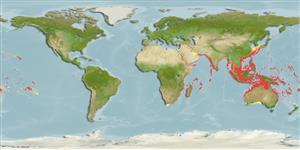>
Carangiformes (Jacks) >
Carangidae (Jacks and pompanos) > Caranginae
Etymology: Caranx: French, carangue, the name of a Caribbean fish; 1836 (Ref. 45335).
More on author: Forsskål.
Environment: milieu / climate zone / depth range / distribution range
Ekologi
laut; payau berasosiasi dengan karang; kisaran kedalaman 10 - 188 m (Ref. 58302). Tropical; 26°C - 29°C; 35°N - 37°S, 19°E - 129°W
Indo-Pacific: Red Sea and east coast of Africa to the Hawaiian and Marquesan islands, north to southern Japan (Ref. 559) and the Ogasawara Islands, south to northern Australia. Hybrid with Caranx melampygus found in Hawaii (Ref. 58422).
Length at first maturity / Size / Weight / umur
Maturity: Lm 60.0 range ? - ? cm
Max length : 170 cm TL jantan/; (Ref. 9710); common length : 100.0 cm TL jantan/; (Ref. 5213); Berat maksimum terpublikasi: 80.0 kg (Ref. 4795)
Duri punggung (Keseluruhan (total)) : 9; duri punggung lunak (Keseluruhan (total)) : 18 - 21; Duri dubur: 3; Sirip dubur lunak: 15 - 17; vertebrata, bertulang belakang: 24. This species is distinguished by the following characters: gill rakers (including rudiments) 5-7 + 15-17 = 20-24; breast naked ventrally, typically with a small to large patch of prepelvic scales; colour in life of adults, head and body silvery grey to black above, usually paler below; fins usually uniformly grey to black, fish from turbid coastal waters often with yellow fins, the anal fin usually brightest (Ref. 9894).
Adults are pelagic over sand and rock (Ref. 58302). They occur singly and inhabit clear lagoon and seaward reefs (Ref. 9710). They feed on crustaceans (like crabs and spiny lobsters) and fishes at night (Ref. 4887). Juveniles are found in estuaries. Large individuals may be ciguatoxic. The largest trevally reaches 1.7 m in length and a weight of over 60 kg (Ref. 48635). Spawning occurs on shallow seaward reefs and offshore banks (Ref. 37816). Sold mostly fresh and dried salted.
Paxton, J.R., D.F. Hoese, G.R. Allen and J.E. Hanley, 1989. Pisces. Petromyzontidae to Carangidae. Zoological Catalogue of Australia, Vol. 7. Australian Government Publishing Service, Canberra, 665 p. (Ref. 7300)
Status IUCN Red List (Ref. 130435)
ancaman kepada manusia
Reports of ciguatera poisoning (Ref. 9710)
penggunaan manusia
Perikanan: komersial; Budidaya air: komersial; Ikan buruan: ya; Akuarium: Akuarium publik
Alat, peralatan
laporan khas
muat turun XML
Sumber internet
Estimates based on models
Preferred temperature (Ref.
123201): 21.2 - 28.4, mean 26.8 °C (based on 1154 cells).
Phylogenetic diversity index (Ref.
82804): PD
50 = 0.5000 [Uniqueness, from 0.5 = low to 2.0 = high].
Bayesian length-weight: a=0.01862 (0.01559 - 0.02224), b=2.95 (2.92 - 2.98), in cm total length, based on LWR estimates for this species (Ref.
93245).
Trophic level (Ref.
69278): 4.2 ±0.4 se; based on diet studies.
Generation time: 13.7 ( na - na) years. Estimated as median ln(3)/K based on 2
growth studies.
Daya lenting (Ref.
120179): sedang, Waktu penggandaan populasi minimum 1.4 - 4.4 tahun (K=0.08-0.11; tm=3.5).
Prior r = 0.56, 95% CL = 0.37 - 0.83, Based on 2 data-limited stock assessments.
Fishing Vulnerability (Ref.
59153): High to very high vulnerability (74 of 100).
Climate Vulnerability (Ref.
125649): High to very high vulnerability (72 of 100).
Nutrients (Ref.
124155): Calcium = 10.8 [4.6, 21.4] mg/100g; Iron = 0.288 [0.152, 0.572] mg/100g; Protein = 20.1 [17.8, 22.6] %; Omega3 = 0.122 [0.069, 0.211] g/100g; Selenium = 62.5 [30.3, 131.1] μg/100g; VitaminA = 56.9 [15.4, 194.6] μg/100g; Zinc = 0.476 [0.338, 0.698] mg/100g (wet weight);
